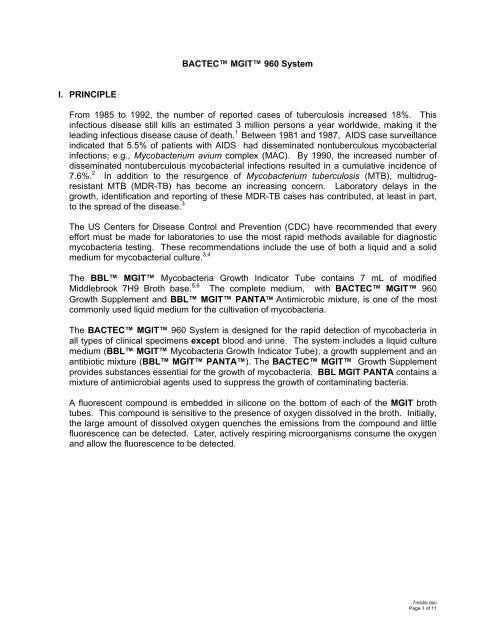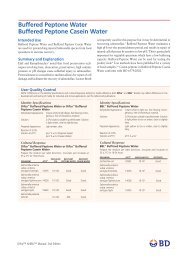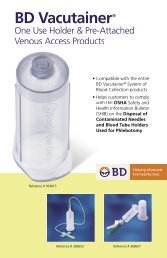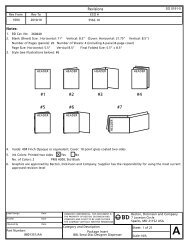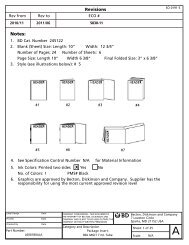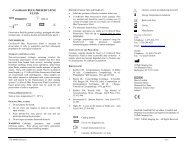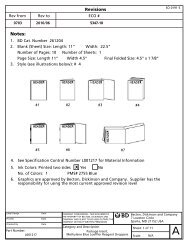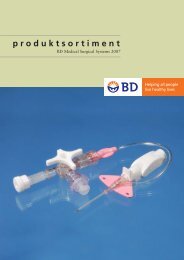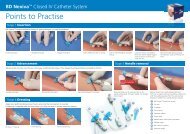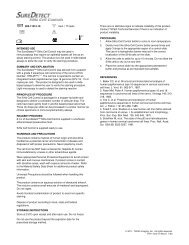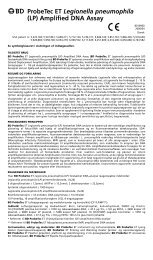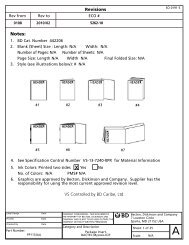BACTEC MGIT 960 SEEDED CULTURE - BD
BACTEC MGIT 960 SEEDED CULTURE - BD
BACTEC MGIT 960 SEEDED CULTURE - BD
Create successful ePaper yourself
Turn your PDF publications into a flip-book with our unique Google optimized e-Paper software.
I. PRINCIPLE<br />
<strong>BACTEC</strong> <strong>MGIT</strong> <strong>960</strong> System<br />
From 1985 to 1992, the number of reported cases of tuberculosis increased 18%. This<br />
infectious disease still kills an estimated 3 million persons a year worldwide, making it the<br />
leading infectious disease cause of death. 1 Between 1981 and 1987, AIDS case surveillance<br />
indicated that 5.5% of patients with AIDS had disseminated nontuberculous mycobacterial<br />
infections; e.g., Mycobacterium avium complex (MAC). By 1990, the increased number of<br />
disseminated nontuberculous mycobacterial infections resulted in a cumulative incidence of<br />
7.6%. 2 In addition to the resurgence of Mycobacterium tuberculosis (MTB), multidrugresistant<br />
MTB (MDR-TB) has become an increasing concern. Laboratory delays in the<br />
growth, identification and reporting of these MDR-TB cases has contributed, at least in part,<br />
to the spread of the disease. 3<br />
The US Centers for Disease Control and Prevention (CDC) have recommended that every<br />
effort must be made for laboratories to use the most rapid methods available for diagnostic<br />
mycobacteria testing. These recommendations include the use of both a liquid and a solid<br />
medium for mycobacterial culture. 3,4<br />
The BBL <strong>MGIT</strong> Mycobacteria Growth Indicator Tube contains 7 mL of modified<br />
Middlebrook 7H9 Broth base. 5,6 The complete medium, with <strong>BACTEC</strong> <strong>MGIT</strong> <strong>960</strong><br />
Growth Supplement and BBL <strong>MGIT</strong> PANTA Antimicrobic mixture, is one of the most<br />
commonly used liquid medium for the cultivation of mycobacteria.<br />
The <strong>BACTEC</strong> <strong>MGIT</strong> <strong>960</strong> System is designed for the rapid detection of mycobacteria in<br />
all types of clinical specimens except blood and urine. The system includes a liquid culture<br />
medium (BBL <strong>MGIT</strong> Mycobacteria Growth Indicator Tube), a growth supplement and an<br />
antibiotic mixture (BBL <strong>MGIT</strong> PANTA). The <strong>BACTEC</strong> <strong>MGIT</strong> Growth Supplement<br />
provides substances essential for the growth of mycobacteria. BBL <strong>MGIT</strong> PANTA contains a<br />
mixture of antimicrobial agents used to suppress the growth of contaminating bacteria.<br />
A fluorescent compound is embedded in silicone on the bottom of each of the <strong>MGIT</strong> broth<br />
tubes. This compound is sensitive to the presence of oxygen dissolved in the broth. Initially,<br />
the large amount of dissolved oxygen quenches the emissions from the compound and little<br />
fluorescence can be detected. Later, actively respiring microorganisms consume the oxygen<br />
and allow the fluorescence to be detected.<br />
7mlclsi.doc<br />
Page 1 of 11
The <strong>BACTEC</strong> <strong>MGIT</strong> <strong>960</strong> System monitors the tubes for increasing fluorescence.<br />
Analysis of the fluorescence is used to determine if the tube is instrument-positive; i.e., the<br />
test sample contains viable organisms. Culture tubes which remain negative for a minimum<br />
of 42 days (up to 56 days) and which show no visible signs of positivity are removed from the<br />
instrument as negatives.<br />
II. MATERIALS<br />
A. MEDIA<br />
1) BBL <strong>MGIT</strong> Mycobacteria Growth Indicator Tube: Each tube contains 110<br />
μL of fluorescent indicator and 7 mL of broth. The indicator contains Tris 4,<br />
4-diphenyl-1, 10-phenanthroline ruthenium chloride pentahydrate in a<br />
silicone rubber base. The tubes are flushed with 10% CO2 and capped with<br />
polypropylene caps. Each tube contains the following active ingredients:<br />
Modified Middlebrook 7H9 Broth Base<br />
Casein peptone<br />
2) <strong>BACTEC</strong> <strong>MGIT</strong> <strong>960</strong> Supplement Kit: Each kit contains:<br />
• 6 vials each containing 15 mL of <strong>BACTEC</strong> <strong>MGIT</strong> Growth Supplement with<br />
the following active ingredients:<br />
Bovine Albumin Dextrose<br />
Catalase Oleic Acid<br />
Polyoxyethylene Stearate<br />
• 6 vials of BBL <strong>MGIT</strong> PANTA Antimicrobic Mixture: Each vial contains<br />
the following lyophilized mixture of antimicrobial agents:<br />
Polymyxin B Naladixic Acid<br />
Amphotericin B Trimethoprim<br />
Azlocillin<br />
B. MATERIALS REQUIRED BUT NOT PROVIDED<br />
Biological Safety Cabinet, Vortex mixer, 37°C Incubator, Lowenstein-Jensen<br />
Medium or solid medium of choice, Middlebrook 7H9 Broth, sterile tubes with glass<br />
beads, 1 mL sterile pipettes, 0.5 McFarland turbidity standard, sterile tubes, sterile<br />
saline, adjustable 1000 μL pipette, sterile tubes, Quality Control organisms<br />
(Mycobacterium tuberculosis ATCC 27294, M. kansasii ATCC 12478, M. fortuitum<br />
ATCC 6841).<br />
C. INSTRUMENT<br />
When microorganisms are present, nutrients in the BBL <strong>MGIT</strong> Mycobacteria Growth<br />
Indicator Tube are metabolized resulting in the depletion of oxygen in the medium.<br />
7mlclsi.doc<br />
Page 2 of 11
III. SPECIMEN<br />
Analysis of the rate of oxygen decrease as measured by increasing fluorescence<br />
enables the <strong>BACTEC</strong> <strong>MGIT</strong> <strong>960</strong> to determine if the tube is instrument positive. A<br />
positive determination indicates the presumptive presence of microorganisms in the<br />
tube.<br />
A. TYPE<br />
<strong>BACTEC</strong> <strong>MGIT</strong> Mycobacteria Growth Indicator Tubes are to be used for culture of<br />
digested and decontaminated clinical specimens (except urine) and sterile body<br />
fluids (except blood).<br />
B. PROCESSING<br />
POTENTIALLY INFECTIOUS TEST SPECIMEN. Observe "Universal Precautions" 7<br />
and institutional guidelines when handling and disposing of infectious materials.<br />
1. Sputum or other respiratory specimens must be digested, decontaminated and<br />
concentrated prior to inoculation into BBL <strong>MGIT</strong> tubes. The N-acetyl-Lcysteine-sodium<br />
hydroxide method is recommended. Alternatively, the BBL<br />
MycoPrep Kit may be used for processing the specimen.<br />
2. Processing of non-respiratory specimens other than blood and urine should be<br />
performed according to the Clinical Microbiology Handbook or the CDC's Public<br />
Health Mycobacteriology: A Guide for the Level III Laboratory. 6,8<br />
C. SPECIMEN LABELING<br />
1. Each specimen should be labeled with the appropriate information:<br />
• Patient' Name<br />
• Hospital number (Patient ID)<br />
• Patient's location (room and bed #)<br />
• Date and time of collection<br />
• Site of specimen<br />
2. Each request slip should also have all the above information.<br />
IV. QUALITY CONTROL<br />
A. MEDIA<br />
Upon receipt of a new shipment or lot number of <strong>MGIT</strong> tubes, it is suggested that<br />
suspensions of the ATCC control organisms shown in the table below be prepared<br />
in Middlebrook 7H9 Broth.<br />
Species ATCC Dilution of 0.5 Days to<br />
7mlclsi.doc<br />
Page 3 of 11
Number McFarland in Instrument<br />
Saline<br />
Positivity<br />
M. tuberculosis 27294 1:500 6 - 10<br />
M. kansasii 12478 1:50000 6 - 11<br />
M. fortuitum 6841 1:5000 1 - 3<br />
1. From solid media cultures less than 15 days old, prepare a suspension in<br />
Middlebrook 7H9 Broth.<br />
2. Allow the suspension to sit for 20 min.<br />
3. Transfer the supernatant to another empty, sterile tube and allow to sit for an<br />
additional 15 min.<br />
4. Transfer the supernatant to another empty, sterile tube.<br />
5. Adjust the suspension to a turbidity comparable to a McFarland No. 0.5 standard.<br />
6. Dilute the control organism suspensions following the dilution scheme outlined in<br />
the above table.<br />
7. Inoculate the BBL <strong>MGIT</strong> tubes following the "Inoculation of <strong>MGIT</strong> Tubes"<br />
procedure.<br />
The BBL <strong>MGIT</strong> tubes should be detected as instrument positive within the time frame<br />
shown in the above table. If the QC <strong>MGIT</strong> tubes do not give the expected results, do not<br />
use the remaining tubes until you have contacted Technical Services at (800)638-8663<br />
(United States only).<br />
B. INSTRUMENT<br />
The following procedures should be performed at the start of each day's testing and<br />
recorded on the maintenance log.<br />
1. Check temperature readout of each drawer by reading the Temperature QC<br />
Tubes. The manual readings should be within +1.0°/-2.0° C of 37° C.<br />
2. Verify that each drawer is currently within 1.5°C of the manual reading for each of<br />
the drawers by pressing the "temperature" soft key.<br />
3. Press the "maintenance" soft key. Press the "test indicators" soft key.<br />
4. Press the "test drawer indicators" soft key. All three external indicator lamps on<br />
all three drawers should light, as well as the instrument Alarm indicator.<br />
5. Open Drawer A. The soft key functions appear to allow tests of the station status<br />
LEDs.<br />
(a) Press the "test green LEDs" soft key. All of the green LEDs at all the stations<br />
should light. If any does not, block the station(s) as described in Section<br />
7mlclsi.doc<br />
Page 4 of 11
V. PROCEDURE<br />
6.2.3.2 - Block Station of the <strong>BACTEC</strong> <strong>MGIT</strong> <strong>960</strong> User's Manual. Press the<br />
"test green LEDs" soft key again to extinguish the green LEDs.<br />
(b) Press the "test red LEDs" soft key. All of the red LEDs at all the stations<br />
should light. If any does not, block the station(s) as described in Section<br />
6.2.3.2 - Block Station of the <strong>BACTEC</strong> <strong>MGIT</strong> <strong>960</strong> User's Manual. Press the<br />
"test red LEDs" soft key again to extinguish the red LEDs.<br />
6. Repeat the tests of red and green station status LEDs for Drawers B and C.<br />
7. Check the printer's paper supply. If the paper supply is low or exhausted,<br />
replace the paper as explained in the manufacturer's operating instructions.<br />
(a) Clean and replace the filters monthly. Refer to the User's Manual, Section<br />
6.2.2.<br />
A. GENERAL SAFETY CONSIDERSTIONS<br />
IMPORTANT NOTE: Please be sure to follow Good Laboratory Practices and<br />
Universal Precautions 7 at all times during the test procedure. All materials should be<br />
disposed of properly as required by your institution.<br />
1. Biosafety Level 2 practices, containment equipment and facilities are recommended<br />
for preparing acid-fast stains and for culturing clinical specimens. For activities<br />
involving the propagation and manipulation of Mycobacterium tuberculosis or<br />
Mycobacterium bovis growth in culture, Biosafety Level 3 practice, containment<br />
equipment, and facilities are required as recommended at the CDC.<br />
2. Perform all specimen processing and positive tube staining or subculturing in a<br />
Biological Safety Cabinet. Appropriate protective clothing, including glove and<br />
masks, should be worn.<br />
3. DO NOT USE tubes showing evidence of contamination or damage. Discard any<br />
tubes if they appear unsuitable.<br />
4. Dropped tubes should be examined carefully. If damage is seen, the tube should be<br />
discarded,<br />
5. Before discarding, place all contaminated BBL <strong>MGIT</strong> tubes and other materials in a<br />
puncture proof container. Autoclave and dispose of according to your facility's<br />
procedure.<br />
B. PROCESSING NEW <strong>CULTURE</strong>S<br />
1. INOCULATION OF <strong>MGIT</strong> TUBES: BBL <strong>MGIT</strong> Tubes (7 mL, Cat no. 245122) must<br />
be used with a <strong>BACTEC</strong> <strong>MGIT</strong> <strong>960</strong> instrument.<br />
7mlclsi.doc<br />
Page 5 of 11
a. Reconstitute a lyophilized vial of BBL <strong>MGIT</strong> PANTA antibiotic mixture with 15 mL<br />
of <strong>BACTEC</strong> <strong>MGIT</strong> Growth Supplement.<br />
b. Label the <strong>MGIT</strong> tube with the specimen number.<br />
c. Unscrew the cap and aseptically add 0.8 mL of <strong>MGIT</strong> Growth Supplement/<strong>MGIT</strong><br />
PANTA antibiotic mixture. For best results, the addition of <strong>MGIT</strong> Growth<br />
Supplement/<strong>MGIT</strong> PANTA antibiotic mixture should be made just prior to<br />
specimen inoculation.<br />
d. Add 0.5 mL of the digested, decontaminated, and concentrated specimen<br />
suspension. Also add a drop (0.1 mL) of specimen to a 7H10 agar plate or other<br />
mycobacterial solid agar or egg-based medium.<br />
e. Tightly recap the tube and mix well.<br />
f. Tubes entered into the instrument will be automatically tested for the duration of<br />
the recommended 42-day testing protocol.<br />
For specimens in which mycobacteria with different incubation requirements<br />
are suspected, a duplicate <strong>MGIT</strong> tube can be set up and incubated at the<br />
appropriate temperature; e.g., 30° or 42° C. Inoculate and incubate at the<br />
required temperature. These tubes must be manually read (refer to the<br />
<strong>BACTEC</strong> <strong>MGIT</strong> <strong>960</strong> User's Manual).<br />
For specimens suspected of containing Mycobacterium haemophilum, a<br />
source of hemin must be introduced into the tube at the time of inoculation<br />
and the tube incubated at 30° C. Aseptically place one strip of BBL<br />
Taxo X factor strip into each <strong>MGIT</strong> tube requiring the addition of hemin<br />
prior to inoculation of specimen (see "Availability"). These tubes must be<br />
manually read (refer to the <strong>BACTEC</strong> <strong>MGIT</strong> <strong>960</strong> User's Manual).<br />
g. Positive tubes, identified by the <strong>BACTEC</strong> <strong>MGIT</strong> <strong>960</strong> instrument, should<br />
be subcultured and an acid fast smear prepared.<br />
All quality control testing, reprocessing, smear preparation, subculturing,<br />
etc., of presumptive positive tubes must be performed using BSL III<br />
practices and containment facilities.<br />
2. ENTERING TUBES INTO THE INSTRUMENT<br />
a. Accession Barcoding Disabled<br />
1) Take the new culture tubes to the instrument. Open the desired drawer.<br />
2) Press the "tube entry" soft key.<br />
3) The barcode scanner turns on and the barcode icon appears in the main<br />
body of the display. Place the tube in the alignment block in front of the<br />
scanner with the barcode label facing the scanner. If necessary, rotate<br />
the tube slightly so the scanner can read the label. The system beeps<br />
once to indicate a good scan.<br />
7mlclsi.doc<br />
Page 6 of 11
4) The assigned station and the scanned sequence number are shown in<br />
the main body of the display. The assigned station LEDs in the drawer<br />
illuminate GREEN.<br />
5) Carefully and completely insert the tube into the designated station.<br />
6) Repeat steps 3 - 5 for each new tube to be entered.<br />
NOTE: Tubes should not be twisted or turned once they are entered into the<br />
appropriate stations. Tubes should only be removed if they are positive,<br />
negative or reassigned due to a bad station.<br />
b. Accession Barcoding Enabled<br />
1) Take the new culture tubes to the instrument. Open the desired drawer.<br />
2) Press the "tube entry" soft key.<br />
3) The barcode scanner turns on and the barcode icon appears in the main<br />
body of the display shows an arrow pointing to the upper barcode (the<br />
tube sequence number). Place the tube in the alignment block in front of<br />
the scanner with the barcode label facing the scanner. If necessary,<br />
rotate the tube slightly so the scanner can read the label. The system<br />
beeps once to indicate a good scan.<br />
4) The icon in the main body of the display shows an arrow pointing to the<br />
lower barcode (the accession number). Scan either the accession<br />
barcode label, or press the "no accession barcode available" soft key.<br />
5) The assigned station, the scanned sequence number and accession<br />
number are shown in the main body of the display. The assigned station<br />
LEDs in the drawer illuminate GREEN.<br />
6) Carefully and completely insert the tube into the designated station.<br />
7) Repeat steps 3 - 5 for each new tube to be entered.<br />
NOTE: Tubes should not be twisted or turned once they are entered into the<br />
appropriate stations. Tubes should only be removed if they are positive,<br />
negative or reassigned due to a bad station.<br />
3. POSITIVE <strong>CULTURE</strong>S<br />
a. The system will indicate the presence of presumptive positive vials in several<br />
ways:<br />
1) The POSITIVE indicator lamp on the front of the drawer illuminates,<br />
2) The tube count for each drawer, next to the filled circle with a plus sign<br />
icon, increments in the Summary window display,<br />
3) When the drawer is opened, the "remove positive tubes" soft key appears<br />
on the screen, and<br />
4) The audible alert sounds until the condition is acknowledged.<br />
b. To Remove the Positive Tubes:<br />
1) Press the SILENCE ALARM key to quiet the audible alarm. Open the<br />
appropriate drawer.<br />
2) Press the "remove positive tubes" soft key.<br />
7mlclsi.doc<br />
Page 7 of 11
3) All the positive stations illuminate with FLASHING GREEN, FLASHING<br />
RED indicators. Remove one of the positive tubes.<br />
4) The barcode scanner turns on and the barcode icon appears in the main<br />
body of the display. Scan the positive tube's barcode label. The LEDs at<br />
this station extinguish.<br />
5) Repeat Steps 4 - 5 to remove additional positive tubes. The POSITIVE<br />
indicator on the front of the drawer and at the top of the instrument will not<br />
extinguish until all positive vials are removed.<br />
6) When all positive tubes are removed, the instrument beeps three times,<br />
the barcode scanner turns off, and the "ok" icon appears in the main body<br />
of the display.<br />
NOTE: All instrument positive tubes should be stained for AFB and<br />
subcultured upon removal from the instrument. Tubes should<br />
remain at room temperature while they are out of the instrument.<br />
c. To Return 'Smear Negative' Positive Tubes:<br />
1) If a presumptive positive tube is determined to be smear-negative for<br />
either mycobacteria or contaminants, the tube should be re-entered into<br />
the instrument within five hours of its removal.<br />
2) To return a smear-negative "positive" tube to the instrument:<br />
a) Open the drawer.<br />
b) Press the "tube entry" soft key.<br />
c) Scan the tube barcode label<br />
d) Place the tube in the indicated station which may differ from the<br />
original station.<br />
4. NEGATIVE <strong>CULTURE</strong>S<br />
• Previous data are retained only if:<br />
The tube is returned within the required time limit (5 hrs.); the barcode<br />
sequence number label is scanned to re-enter the tube; or the tube is<br />
returned to the same instrument from which it was removed.<br />
a. Negative cultures exist as ongoing negatives (in protocol) or out-of-protocol<br />
negatives. Notification of these conditions include:<br />
1) Ongoing Negatives - In the Summary region of the display, the ongoing<br />
tube count for each drawer appears next to the filled circle icon,<br />
2) Out-of-protocol Negatives - In the Summary region of the display, the<br />
tube count for each drawer appears next to the filled circle with a minus (-<br />
) sign icon, and<br />
3) The negative indicator light for the drawer(s) illuminates.<br />
b. To Remove Out-of-Protocol Negatives:<br />
1) Open the appropriate drawer.<br />
2) Press the "remove negative tubes" soft key.<br />
3) All the final negative stations illuminate with FLASHING GREEN<br />
indicators.<br />
7mlclsi.doc<br />
Page 8 of 11
4) The barcode scanner turns on and the barcode icon appears in the main<br />
body of the display, signaling that the instrument is ready to read a tube<br />
barcode sequence number.<br />
5) To remove all negative tubes (batch removal), press the "remove<br />
negatives - batch" soft key. Remove all the tubes in the indicated<br />
stations. The barcode scanner turns off, so that barcode labels cannot be<br />
scanned. Do not close the drawer until all of the tubes in the FLASHING<br />
GREEN stations have been removed. When all negative tubes are<br />
removed, press the "ok" soft key.<br />
6) To remove negatives one at a time, remove the de- sired tube and scan<br />
the barcode label. Continue to scan and remove all the desired individual<br />
negative tubes.<br />
7) When all negative tubes are removed, the instrument beeps three times,<br />
and the "ok" icon appears in the main body of the display.<br />
5. PROCESSING OF POSITIVE <strong>MGIT</strong> TUBE(s):<br />
IV. LIMITATIONS<br />
NOTE: All steps should be performed in a biological safety cabinet.<br />
1) Remove the positive <strong>MGIT</strong> tube from the instrument and transport to an<br />
area using BSL III practices and containment facilities.<br />
2) Using a sterile transfer pipette, remove an aliquot from the bottom of the<br />
tube (approx. 0.1 mL) for stain preparations (AFB and Gram stains),<br />
3) Inspect smear preparations. Report preliminary results only after acidfast<br />
smear evaluation.<br />
4) Follow the established procedure(s) for reporting results.<br />
Recommended actions may be:<br />
a) If AFB positive, subculture to solid media and report as:<br />
instrument-positive, AFB-positive, ID pending. Subculture and<br />
identify organisms according to your laboratory protocol.<br />
b) If microorganisms other than acid-fast bacilli are present, report<br />
as: instrument-positive, AFB-negative, Contaminated. Refer to<br />
the <strong>BACTEC</strong> <strong>MGIT</strong> <strong>960</strong> User's Manual, Appendix E for tube<br />
decontamination procedure.<br />
c) If no microorganisms are present on the smear, re-enter the tube<br />
into the instrument as an ongoing negative and allow the vial to<br />
complete testing protocol. No reportable result.<br />
Recovery of mycobacteria in the BBL <strong>MGIT</strong> tube is dependent on the number of organisms<br />
present in the specimen, specimen collection methods, patient factors such as presence of<br />
symptoms, prior to treatment and the method of processing.<br />
Decontamination with the N-acetyl-L-cysteine-Sodium hydroxide (NALC-NaOH) method is<br />
recommended. Other decontamination methods have not been tested in conjunction with<br />
the BBL <strong>MGIT</strong> medium. Digestant/decontaminant solutions may have harmful effects on<br />
mycobacteria.<br />
7mlclsi.doc<br />
Page 9 of 11
Colony morphology and pigmentation can only be determined on solid media.<br />
Mycobacteria may vary in acid-fastness depending on strain, age of culture and other<br />
variables. The consistency of microscopic morphology in BBL <strong>MGIT</strong> medium has not been<br />
established.<br />
An AFB smear-positive BBL <strong>MGIT</strong> tube can be subcultured, to both selective and<br />
nonselective mycobacterial media, for isolation to perform identification and susceptibility<br />
testing.<br />
BBL <strong>MGIT</strong> tubes which are instrument-positive may contain other non-mycobacterial<br />
species. Non-mycobacterial species may overgrow mycobacteria present. Such <strong>MGIT</strong><br />
tubes should be re-decontaminated and re-cultured (refer to the <strong>BACTEC</strong> <strong>MGIT</strong> <strong>960</strong><br />
User's Manual). Reprocessing is strongly recommended if the original specimen source<br />
cannot be easily re-collected; e.g., tissue specimen.<br />
BBL <strong>MGIT</strong> tubes which are instrument-positive may contain one or more species of<br />
mycobacteria. Faster growing mycobacteria may be detected prior to slower growing<br />
mycobacteria; therefore, it is important to subculture positive <strong>MGIT</strong> tubes to ensure proper<br />
identification of all mycobacteria present in the sample.<br />
Due to the richness of the BBL <strong>MGIT</strong> broth and to the non-selective nature of the <strong>MGIT</strong><br />
indicator, it is important to follow the stated digestion/decontamination procedure to reduce<br />
the possibility of contamination. Adherence to procedural instructions, which includes use<br />
of recommended inoculum volume (0.5 mL) is critical for optimum recovery of<br />
mycobacteria.<br />
The use of BBL <strong>MGIT</strong> PANTA antibiotic mixture, although necessary for all nonsterile<br />
specimens, may have inhibitory effects on some mycobacteria.<br />
V. REFERENCES<br />
1. Bloom, B. R., and C. J. L. Murray. 1992. Tuberculosis: commentary on a reemergent<br />
killer. Science 257:1055-1064.<br />
2. Horsburg, C.R., Jr. 1991. Mycobacterium avium complex infection in the acquired<br />
immunodeficiency syndrome. N. Engl. J. Med. 324:1332-1338.<br />
3. Tenover, F. C., et al. 1993. The resurgence of tuberculosis: Is your laboratory ready?<br />
J. Clin. Microbiol. 31:767-770.<br />
4. Cohn, M. L., R. F. Waggoner, and J. K. McClatchy. 1968. The 7H11 medium for the<br />
cultivation of mycobacteria. Am. Rev. Resp. Dis. 98:295-296.<br />
5. Youmans, G. P. 1979. Cultivation of mycobacteria, the morphology and metabolism<br />
of mycobacteria, p. 25-35. Tuberculosis. W. B. Saunders Company, Philadelphia.<br />
6. Kent, P. T., and G. P. Kubica. 1985. Public health mycobacteriology: a guide for the<br />
level III laboratory. USDHHS, Centers for Disease Control, Atlanta.<br />
7. Bloodborne pathogens. Code of Federal Regulations, Title 29, Part 1910.1030.<br />
8. Isenberg, Henry D. (ed.). 1992. Clinical microbiology procedures handbook, vol. 1.<br />
American Society for Microbiology, Washington, D.C.<br />
<strong>BACTEC</strong>, BBL, <strong>MGIT</strong>, MycoPrep, PANTA and TAXO are trademarks of Becton Dickinson and<br />
Company.<br />
ATCC is a trademark of the American Type Culture Collection.<br />
7mlclsi.doc<br />
Page 10 of 11
Approved By:__________________________<br />
Date Effective:_________________________<br />
Supervisor:_______________________ Date:_____________<br />
Director:_________________________ Date:_____________<br />
Reviewed:<br />
Rev. 10/99<br />
7mlclsi.doc<br />
Page 11 of 11


